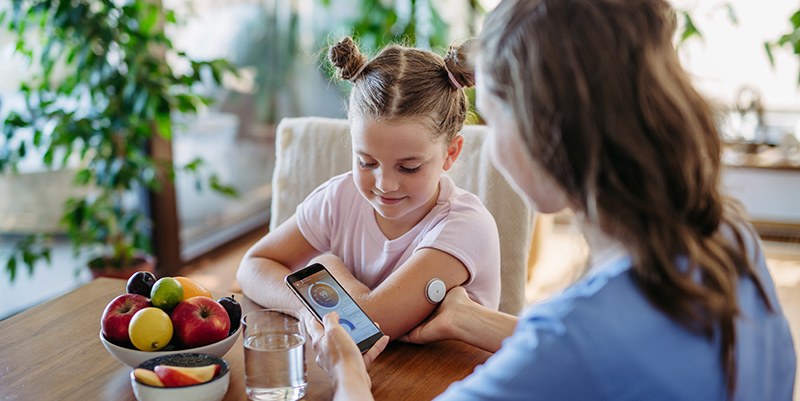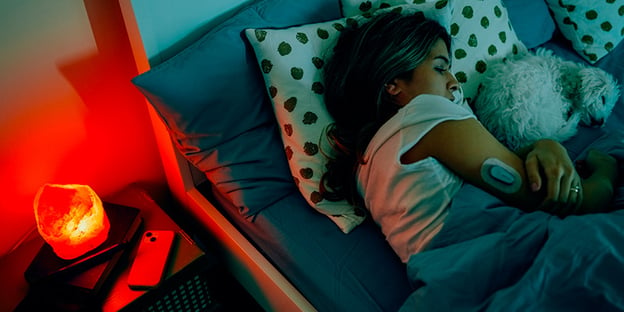Diabetes and parenthood are huge challenges separately. When you add them together, it can seem like an even bigger dilemma, especially for those who have never experienced diabetes themselves.
And while a continuous glucose monitor (CGM) can be a huge gamechanger, it can bring up challenges of its own. How can you teach your child to effectively use the data? Who should see the information? How can your teen with diabetes wear a CGM without giving up their favorite sports or school activities?
Luckily, you don’t have to face any of these questions alone. There are plenty of strategies to overcome some of the common challenges faced by children with diabetes and their caregivers.
Guilt and Misconceptions Around Diabetes in Children
Your first response to the news that your child has diabetes might be guilt. It’s natural to search for blame for life-changing news like this, and it’s common for that blame to turn inward. But diabetes is no one’s fault. It comes from a combination of environmental and hereditary causes that are mostly out of your control. And often, it can skip several generations, so whether you have it has little bearing on whether your child will.
More importantly, diabetes isn’t a death sentence. It doesn’t even have to get in the way of daily life. Your child can live a full, happy, and healthy life with Type I or Type II. They don’t have to skip birthday parties or always eat apples when everyone else is having cupcakes. They just need the right tools and behaviors to help them manage their diabetes.
Using Continuous Glucose Monitors (CGMs)
One of those tools is a CGM. Children as young as 2 can use them to monitor their blood glucose levels and make choices to mediate them. What’s more, they can easily share the data with you, their care team, and even their school nurse so everyone involved can help prevent hypoglycemia.
They’re also a great way to teach your child independence. Eventually, they’ll be managing their diabetes on their own, so learning to read the trend arrows and make decisions about food, exercise, and behavior based on them is essential. And older children may not want their parents to monitor their CGM data, so empowering them to do it themselves is an important way to build their confidence and give them more responsibility.
It's also important to let your children make decisions about where to place the CGM. The Libre is approved for placement on the upper arm, and the Dexcom is approved for placement on the upper arm, abdomen, or buttocks. Your child might not like wearing it in one spot but feel fine about wearing it in another approved spot. As long as the new spot falls within the manufacturer’s guidelines, let kids decide where it’s most comfortable to wear. And let your child gradually learn to attach their own CGM. They may eventually want to go to sleepovers or on school trips where you won’t be there to do it for them. The more they practice doing it themselves, the more confident they’ll get.
Some children can have sensitivities to the adhesive used with CGMs. A small spot right after removal is normal, but if it doesn’t go away, talk to your doctor. They could be allergic to the adhesive.
Children active in sports or who frequently swim may have trouble with the CGM sticking to their skin because of the extra moisture. When you order from TMS, we include extra Skin Tac adhesive to ensure the CGM stays on for the full 10- to 14-day wear period. And because of the adhesive used, it’s important not to attach your child’s CGM within an hour of swimming, bathing, showering, or profusely sweating.
Lack of Support Systems for Children With Diabetes
Another challenge that comes with childhood diabetes is ensuring they have a solid support system. If you have never dealt with diabetes yourself, you may not know how to answer certain questions or handle certain topics that come up around diabetes, like teasing, not wanting to wear a CGM because they’re afraid of being singled out and feeling different than their classmates, etc.
It might be helpful for your child to have a mentor who has experienced these same problems. Maybe they have an uncle or teacher who has diabetes who can talk them through some of those issues. Maybe they can follow celebrities like Nick Jonas or various TikTok or YouTube influencers who discuss how they overcame challenges with diabetes. Or perhaps they can attend a diabetes camp, where children with diabetes meet new friends, learn to manage their diabetes under medical supervision, and—for many—get to feel like they fit in for the first time since their diagnosis.
Access to Healthy Food/Resources
Eating the right foods is everything when it comes to managing your diabetes. But in some areas, it can be tough to access the right foods, like fresh fruits and vegetables, especially when you’re on the go. And that can make children reach for junk food, which can do a number on their blood glucose levels. But your children won’t always have you around to monitor what they eat and make their dietary choices for them. So, empower them with strategies to make healthy choices easier to make. Teach them how to “budget” carbs for things they want, like cupcakes at a birthday party, while choosing lower-carb options the rest of the day to balance out the treat. Make sure they know how to read their trend arrows to see what their blood sugar is doing before they eat. And teach them to choose healthy foods, like Greek yogurt, chopped-up fruit or carrot sticks, or salads at convenience stores like 7-11.
Resources for parents and kids
DiabetesEducator.Org. Here, you’ll find tips for parents, booklets for children and young adults, stories from diabetes camp, and more.
ChildrenWithDiabetes.com. This nonprofit offers great resources for children and their parents, like articles for those new to diabetes and a portal to ask questions about the disease.
DiaTribe.org. While not specific to children, this diabetes resource is packed with information for people of all ages with diabetes.
Diabetes.org. The website of the American Diabetes Association has great information for caregivers.
ADA Diabetes Camp list. The ADA also has a great list of diabetes camps to help you find one near you.
A child with diabetes can live the same full life as one without it. They just need to learn how to manage the disease effectively. With a CGM and your support, they’ll have everything they need to do that throughout their lives.
Ready to advocate for a CGM for your child?
First, use our handy guide to determine which kind of CGM Is best for their lifestyle, then, follow these steps:
- Print the guide or save it to your phone.
- Take the guide to their next doctor’s appointment.
- Discuss the CGM that will work best for their unique needs.
- Ask their doctor for a prescription.
It’s that easy!
A CGM system can be life-changing for patients with diabetes because it’s an easier, more comprehensive, and more convenient way to manage your diabetes and improve your quality of life.







